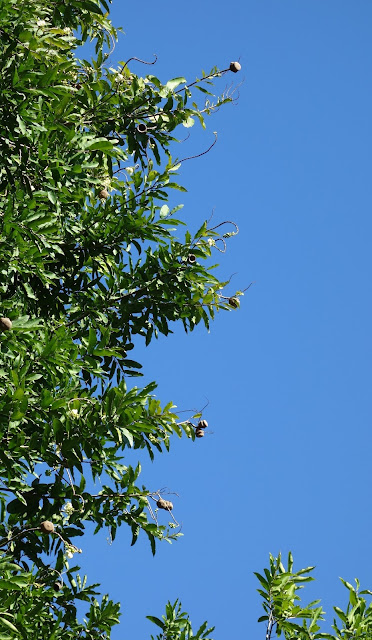With 97 hectares it’s one of the oldest institutions of its kind on the island, founded in 1901 by Edwin F. Atkins and his wife. They arrived in Cuba in 1899 in search of the island's most precious commodity; sugarcane. Atkins built the “Soledad” sugar mill and soon after a research center dedicated to investigation and enhancement of sugar cane under the name: "Harvard Botanical Station for Tropical Research and Sugar Cane Investigation." Mr. and Mrs. Atkins were also fond of plant collecting and soon afterwards started a tropical and rare species garden in the backyard of their estate where plants from as far as India and China were grown in tropical Cuba. Today the garden has a large collection of tropical exotic plants (2000+ species) clustered in 670 general and 125 botanical families. Among the most complete collections are orchids (400+), palms (230+), ficus (65+) and bamboo (29). (from Wikipedia)
here are some photos - starting with the palms -
the petticoat palm (native to Cuba)
then the epiphytes- a plant that grows on another plant but is not parasitic, such as the numerous ferns, bromeliads, air plants, and orchids growing on tree trunks in tropical rain forests.
then some flowering things- LOL
some bamboo-

and some other cool things-
a sausage tree (like the ones in Africa)
the offices were in this very nice building and there was a bar-cafe on the premises where you could have rum drinks (at ten in the morning LOL it didn't appeal)
but here was the coolest photo of the morning- aren't spiders amazing?!
then we actually went over to the Soledad sugar plantation (mostly abandoned) as a substitute for the center in Valley de los Ingenios or Valley of the Sugar Mills, a series of three interconnected valleys about 7.5 miles outside of Trinidad, Cuba. The three valleys were a centre for sugar production from the late 18th century until the late 19th century. At the peak of the industry in Cuba there were over fifty sugar cane mills in operation in the three valleys, with over 30,000 slaves working in the mills and on the sugar cane plantations that surrounded them. The entire area covers 100 square miles and includes the sites of over 70 former sugar mills. (wikipedia)
because there was apparently some rehabbing going on at the center there (which was to my mind a waste of time last time) and it was closed - this was way cooler because we got to see the abandoned house and talk to the people in town about how things went after the sugar mill shut down (this one ran until the "special period" I think)
locals were still cooking in the kitchen-
The estate was built up during the era of slave labor - in 1886 slavery was finally abolished in Cuba by Spanish royal decree that also made an indentured servitude system, known as "patronato," illegal. However, the land continued to be a working sugar plantation well after abolition.
By 1894, Atkins' holdings at Soledad totaled some 12,000 acres and a grinding capacity of 120,000 tons of cane and 1200 employees during cane cutting season. [11] The 5,000 acres planted in sugar cane probably produced more than 4,000 tons of sugar a year. At the New York price of 3.2 cents per pound in 1894, that would have produced gross revenues from Soledad of over $256,000. The Soledad central also ground the cane for surrounding colonos and profited from other activities such as financing the surrounding colonos. These brought Soledad revenues to over a million dollars per year. (from Edwin F. Atkins and the Evolution of American Cuba Policy: 1894-1902 ©1998 Christopher Harris) now all gone... just a shell of a town with the "manor house" and various other buildings left to nature more or less...
back on the road and off to Trinidad- we stopped along the way at a fruit vendor and got to taste his wares and see his home which the family has been improving with their success as fruit sellers along the road between Cienfuegos and Trinidad...
the bananas were terrific- sweet and perfectly ripe - not overly ripe...
ginger - which was used for tea that we tried-
the bedroom - in the newer addition to the house-
metal is precious in Cuba and so no one has a closet per se with hangers- every where we went the working people used shelves like these in their rooms for their personal items-
the "bathroom" with shower (off to the left of the toilet) and toilet-
the outdoor kitchen - with old washing machine (belt driven)
in the living area - TV and iPod!
on to Trinidad - but in another post because this one has become quite long enough! stay tuned - I think Trinidad - an almost pristinely preserved colonial town is one of the highlights of the trip....



























































No comments:
Post a Comment